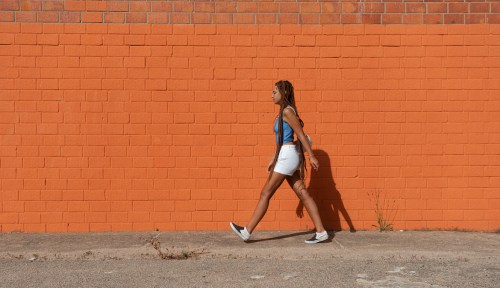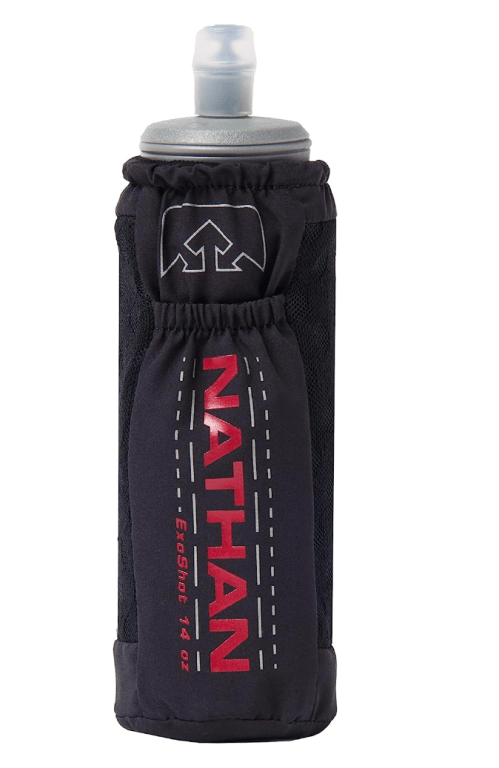Our editors independently select these products. Making a purchase through our links may earn Well+Good a commission
8 Ways To Make Walking in the Heat More Bearable, According to a Walking Coach
If you're getting too hot walking, learn about strategies a pro walking coach uses to stay cool on the road when temps soar.

If the mention of a heat wave makes you want to hide from the outdoors and curl up with a slushie in hand, you’re not alone. Getting out and about in hot temperatures—let alone trying to exercise in them—can be daunting. But there’s no need to fear. You can still get in outdoor workouts like walking in most temps as long as you’ve got the proper preparation and approach. (Hint: It involves consuming your favorite non-caffeinated cold beverage.)
Experts in This Article
exercise physiologist at NYU Langone’s Sports Performance Center
walking coach, founder of WoW Power Walking, and ACE-certified personal trainer
And there’s good reason to hit the pavement even when it’s hot enough to fry an egg: It’s a known fact that walking outdoors has many positive benefits for the body—whether it be increased blood flow to the brain and better cardiorespiratory fitness or greater feelings of overall happiness and improved mental health.
But doing your “hot girl walk” in hot weather can lead to a significant—and sometimes dangerous—increase in your body temperature. “People are at risk of dehydration because you are sweating very easily,” says Lee Scott, Toronto-based walking coach and founder of WoW Power Walking. And, she adds, your core temperature can potentially reach unhealthy levels.
“Exercising in temperatures higher than 91.4 degrees Farenheit can increase the risk of heat exhaustion, which occurs when the body is unable to maintain proper blood flow to all organs and the skin for thermoregulation at the same time,” Heather Milton, CSCS, a board-certified clinical exercise physiologist at NYU Langone’s Sports Performance Center, previously told Well+Good. Signs of heat exhaustion to look out for include excessive fatigue, fainting, and not feeling able to exercise any longer.
So how can you safely keep up your daily 10,000 steps (or however many you like to aim for)? Scott, co-author of The Walking Solution, shared with Well+Good some tips that can help make walking in the heat more bearable. Before you grab your Airpods and soak in your daily dose of vitamin D, here are a few things to know.
1. Try to walk in the early mornings or late evenings
“I always recommend people go out early in the day, and I think it’s a common tip among exercisers before all the smog builds up,” says Scott. Not only is it cooler, the air quality is typically better first thing in the morning. If you are unable to fit in a walk early on, walking at night when temperatures are lower is also an option.
2. Choose your path wisely
This might sound like common sense, but it can truly make a difference: Walk on a trail or path that has shaded areas. If you are in a city, walk along a tree-lined avenue or in between tall buildings that offer shade from the sun. One smart strategy is to head somewhere with shops—this way you can step into the air conditioning for a few minutes if you need to. For people who live in a suburban or rural area, choose a trail that has plenty of shaded areas and places to hydrate (like public water fountains at a park).
If nowhere outside feels comfortable, don’t rule out an indoor mall, which will let you stay inside of air conditioning and avoid UV rays while you’re at it.
3. Keep your head and face cool
Keeping the head cool can help you decrease your body’s rising temperatures as you walk. “I often wet my hat to keep cool,” says Scott. (This is a strategy that pro marathon runners use, too.)
Studies show that head cooling helps to improve athletic performance and reduces fatigue following a workout. Intermittent face cooling such as face misting has also been found to improve endurance in hot environments. Try running cool water over your head whenever you pass a water fountain or carrying ice water that you can dump on top when you start to get too toasty.
Also, it can help to keep your face out of the sun: Wear a visor, sunglasses, or a hat.
4. Stay hydrated and be prepared to sweat!
You’ve heard it before, but it’s worth repeating: As you sweat, you need to replenish your body with fluids. On hot days, you should hydrate every 15 to 20 minutes with at least eight ounces of water when exercising in the heat, according to the Centers for Disease Prevention and Control. If there aren’t water fountains on your route, bring along a water bottle. And if you’re out there for a long time, or if you know you’re a heavy sweater, consider adding electrolytes.

Nathan ExoDraw & ExoShot 2.0 Flask — $40.00
This is our editor’s top rec for a handheld water bottle on the go. Nathan’s ergonomically-designed bottle comes with a hand strap that lets you comfortably hold it without having to think about it. Even better, the collapsible flask shrinks as you drink, so water doesn’t slosh around, and the sports nozzle makes it easy to sip as you walk.
ThirdLove Just Launched Bras That Help Balance Your Body Temperature—Here’s Why That’s a Game-Changer for Women in All Life Stages

These Are the Only Types of Underwear You Should Be Wearing, According to Gynecologists

These Are the Summer Essentials You Should Bring With You Every Time You Leave the House, According to a Derm and an RD

5. Try pre- and post-cooling
Before heading out into high temps, you can prepare your body by cooling off inside (aka standing in front of the AC, maybe with a couple of ice packs) and drinking cold beverages like a slushie or smoothie. Research shows that these strategies can reduce your body’s core temperature even once you begin to exercise, helping to improve your safety and endurance while exerting yourself in hot weather.
And don’t forget about bringing your body temp back down after you’re done walking: Scott also suggests taking a cool shower after your workout, if possible.
6. Dress strategically
Aim to wear lightweight, breathable attire in light colors that reflect in the sun. Tight-fitting clothes can trap the heat, and designs that leave room for skin-to-skin contact (like tank tops) can cause chafing, depending on your body, so test out different styles until you find what’s comfortable for you. And stick with sweat-wicking socks—old-school cotton options can end up creating friction and lead to blisters. Lastly, Scott recommends choosing comfortable running shoes that feature mesh material on top and have a low heel profile.
7. Listen to your body
If at any time you begin to feel excessive fatigue or feel like you can’t walk any further, give yourself a break. “If you absolutely feel like the heat is too much, then you need to stop walking and find a cool place in the shade to bring your temperature down or step indoors,” says Scott. If you keep pushing through, you could put yourself at risk for heatstroke, which requires immediate medical attention.
8. Give yourself time to acclimate
If you are new to walking or the temps have suddenly spiked, remember your body has to become acclimatized to the heat. Over the course of a few weeks, your body will gradually adjust to walking in the heat. Start slowly with shorter walks at a reasonable pace. “Over time you will be able to increase your pace,” says Scott. “Trust what your body is telling you in terms of speed.”
Sign up for the Well+Good SHOP Newsletter
Get exclusive deals on wellness, beauty, fitness, and food products that have been hand-picked by our editors.
Got it, you've been added to our email list.







